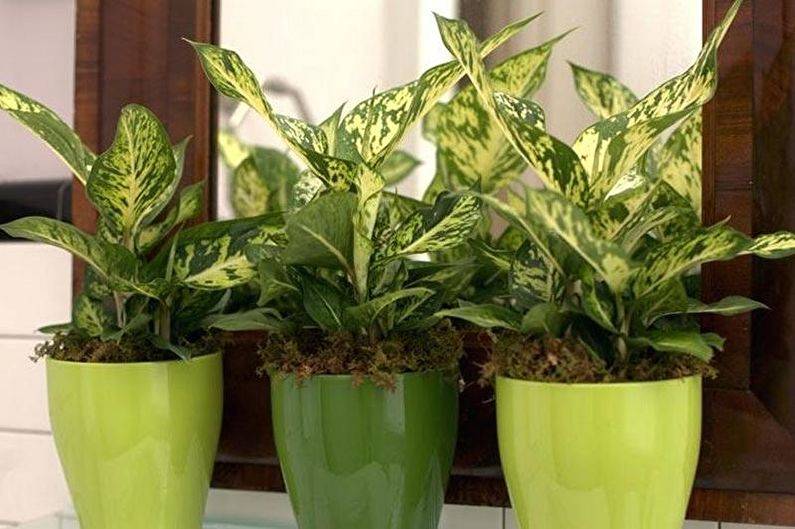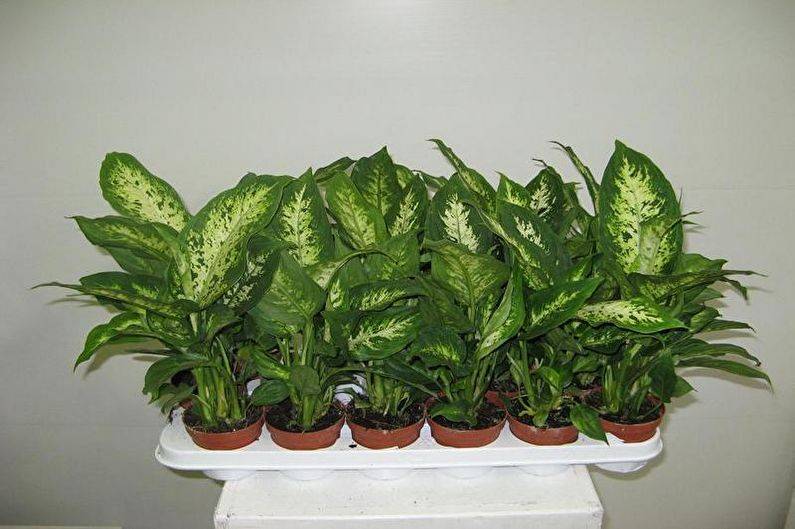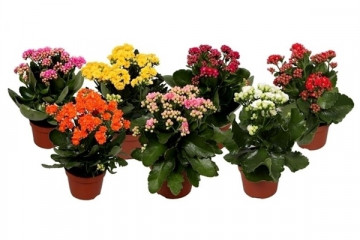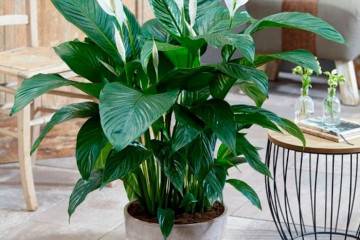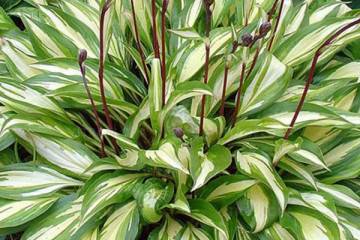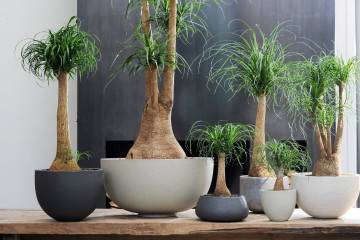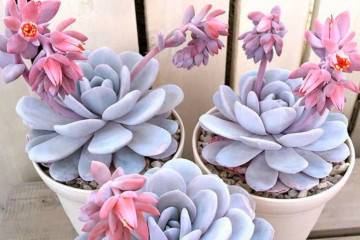Dieffenbachia - species, how it blooms, is it poisonous or not
Content:
Beauty dieffenbachia dieffenbachia comes from South America. There, in natural conditions, in the wild, there are more than fifty species of it. Despite some finickyness and exactingness in the care of certain species, this plant is very popular as a houseplant. In addition, the bright and spotted color of varieties adapted for home cultivation will leave few people indifferent.
Dieffenbachia description
The plant is tree-like. It has a straight, succulent trunk and large, oval, slightly elongated leaves. Their color attracts attention with its variegation and quirkiness of the pattern. Dieffenbachia grows quite quickly (if you provide it with proper care, new leaves will appear almost every week) and can reach 1.5-2 m at home. So you need to be prepared that a small plant will reach the ceiling in a few years. At home, it reaches a height of 3-3.5 m.
The disadvantage of the plant is that over time it sheds the lower leaves and, as a result, loses its decorative effect. A way out of this situation can be its frequent renewal (once every 3-4 years) - cut off the top and root it. Or, if the area permits, you can plant plants of different heights in one tub and then, thanks to several tiers, it will look spectacular.
In indoor conditions, it is quite rare for a flower to bloom. And if you are lucky to see how Dieffenbachia blooms, then it will be a nondescript ear in the leaf sinus. Flowering lasts only a few days, then the flower begins to wither. Over time, a bright orange or red berry will appear in its place.
Dieffenbachia flower: home care
The plant without fail requires regular watering and frequent irrigation, as it needs high humidity. The transplant, depending on the variety, is carried out every 2-3 years or as needed. Top dressing is best done during the active growing season of the plant - from spring to autumn. Fertilize the flower with special complex mineral fertilizers. But in the winter it is better to give him a rest.
Dieffenbachia: types
The species diversity of the plant is impressive even for demanding growers. Among the variety of varieties and hybrids, the following types are the most popular for indoor cultivation:
Dieffenbachia Camilla
Dieffenbachia Camilla is a species of spotted, but at the same time it is radically different in color: almost the entire surface of the leaf is white and only becomes slightly green over time.
Dieffenbachia Compact
Dieffenbachia Compact is derived from Spotted. The leaves of the variety are oval, green, with large white spots.The plant needs good lighting, so staying in dark corners of the room has a negative effect on its appearance: the foliage becomes noticeably smaller and loses its decorative effect. This dieffenbachia, the flowering of which is not a special sight, since the flowers are small and inconspicuous. She absolutely cannot stand cold and drafts.
Dieffenbachia Mix
There are many varieties of Dieffenbachia Mix. Differs in light green leaves with patterns of varying intensity, loves light. The variety boasts of its decorative effect, so it can often be found in various public places.
Dieffenbachia Reflector
A bright and colorful variety of the spotted variety is the Diphenbachia Reflector. The plant is characterized by a compact size and an unusual camouflage color (there are numerous lettuce and yellow spots on a dark green background) of oval leaves with a white central vein.
The reflector is very fond of good lighting, direct sunlight does not pose a danger to it. But the presence of drafts and the air temperature is less than 12-13 degrees Celsius can destroy the plant.
Dieffenbachia Tropic Snow
The variety has abundant foliage with pointed tips. On the edges of the plate is green, and the middle is in whitish veins and light specks, reminiscent of snow flakes.
Dieffenbachia Vesuvius
This variety is perhaps one of the most variegated. Differs in light-requiring and not too tall.
Dieffenbachia Seguin
This type of plant is distinguished by a thick fleshy stem and large lobed leaves, on which the veins are clearly visible. The color of the leaves is bright green or there is a small variegated pattern. Dieffenbachia Seguina became the original variety, on the basis of which many different hybrids were bred, differing in the variegated color and shape of the leaves.
The plant loves the sun, but it will develop quite normally in the shade. Needs regular irrigation and does not tolerate dry air. But with an excess of moisture, as with drought, his leaves turn yellow and crumble.
Dieffenbachia Green Magic
This variety is the result of the work of breeders with the Seguin Dieffenbachia. Its leaves are dull; the central white vein contrasts sharply with the dark green surface of the plate. The variety is characterized by a small number of veins.
Dieffenbachia Adorable
What does Dieffenbachia look like? Many people know this adorable one - this is perhaps the most popular variety for home cultivation. This is explained by the fact that the plant is unpretentious to the conditions of detention: it does not need mandatory good lighting, it is not afraid of dry air with centralized heating. In addition, this variety boasts large decorative leaves, tall growth and a powerful stem that does not need support.
Dieffenbachia Charming perfectly tolerates pruning: it is capable of giving side shoots, making it possible to adjust the shape of the bush.

It is better to remove the appeared flower after a couple of days - the plant spends a lot of energy on it
Dieffenbachia Spotted
On large leaves of a dark green color of Dieffenbachia Spotted, white veins and light creamy blotches are clearly visible. This variety has also become the basis for several types of decorative hybrids.
A characteristic feature of this variety is its ability to grow rapidly, but as soon as it reaches a meter height, growth stops. And Spotted can rightfully be proud of its lush foliage. Therefore, adult plants, which eventually lose their lower leaves, resemble small trees with a lush crown.
Dieffenbachia Green
It is distinguished by oval, slightly pointed leaves and a green color of the plate with a clearly visible light central vein.
Dieffenbachia: is it poisonous to humans or not?
Many lovers of indoor flowers often doubt whether it is worth keeping this plant at home, as they have heard about its possible harm to human health. Is it a dangerous flower for growing at home?
Dieffenbachia - harm to humans
Many are interested in the question: dieffenbachia is poisonous or not. Definitely, you shouldn't be afraid of it. On the contrary, given all the beneficial properties that it possesses (it is able to neutralize harmful substances in the air, destroy harmful microbes, increase the humidity in the air in the room), it is very useful to grow a plant at home - it can improve health.
You just need to be careful when carrying out a flower transplant: only the plant sap is harmful, so it should not come into contact with the skin and mucous membranes, otherwise it is fraught with the manifestation of allergic reactions. If the juice enters the digestive system, symptoms of poisoning may occur, so it is better to keep the plant away from children.
Dieffenbachia-like flower
Quite often, diffebachia is confused with a plant called aglaonema. They are similar to each other with their spotted coloring and large decorative leaves. Both plants belong to the Aroid family and grow in the tropics. But these plants have a different structure: Dieffenbachia, unlike aglaonema, forms a single stem with a growing point at the top.
Keeping dieffenbachia in your home is not so difficult if you follow certain rules for caring for it. The plant needs frequent watering and irrigation, good lighting and regular feeding. And in return, the flower will thank it with fast growth and colorful large decorative leaves.
Not everyone is able to see how dieffenbachia blooms - this happens quite rarely. But the indisputable fact is that the plant will be beneficial: it is able to purify the air in the room, absorbing harmful substances from it.
